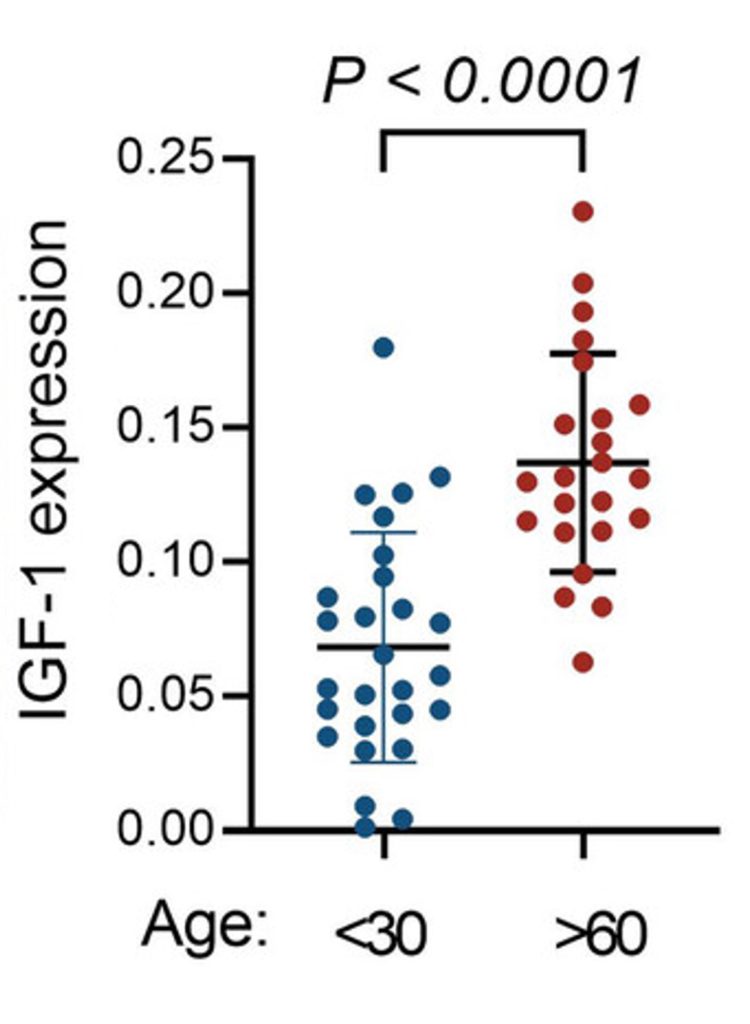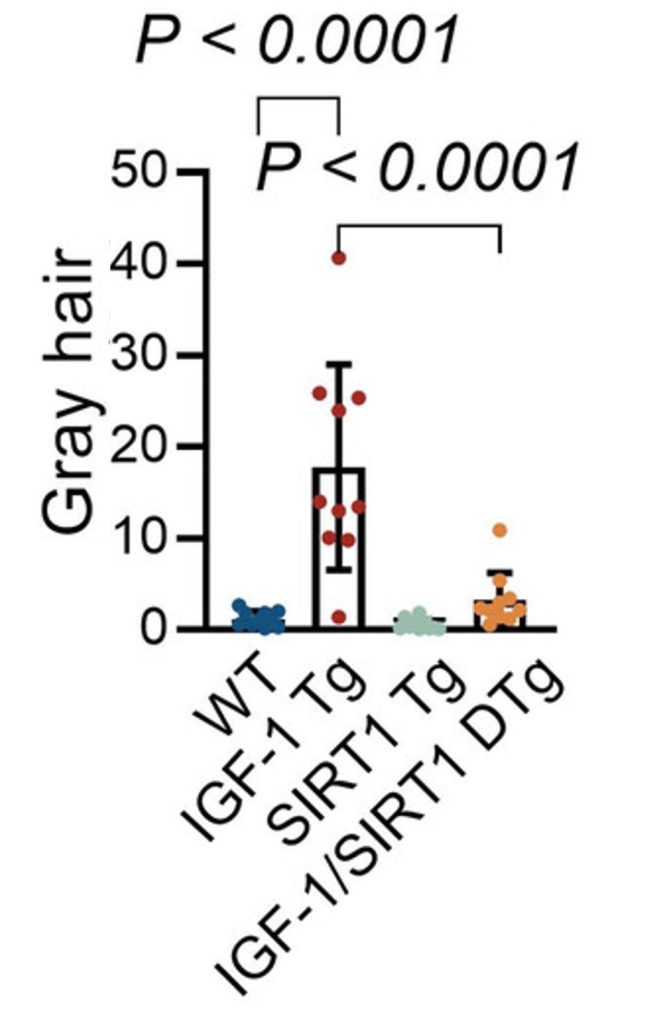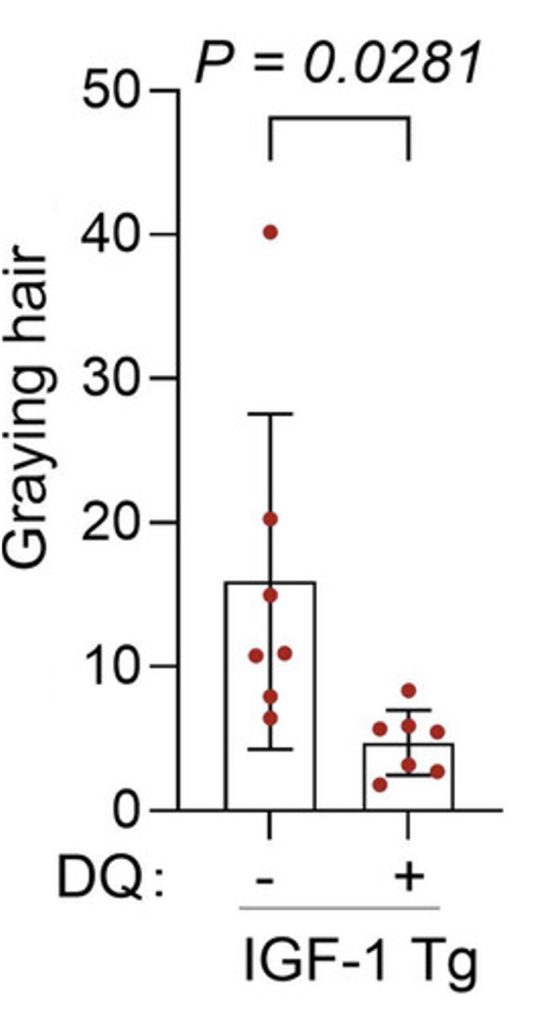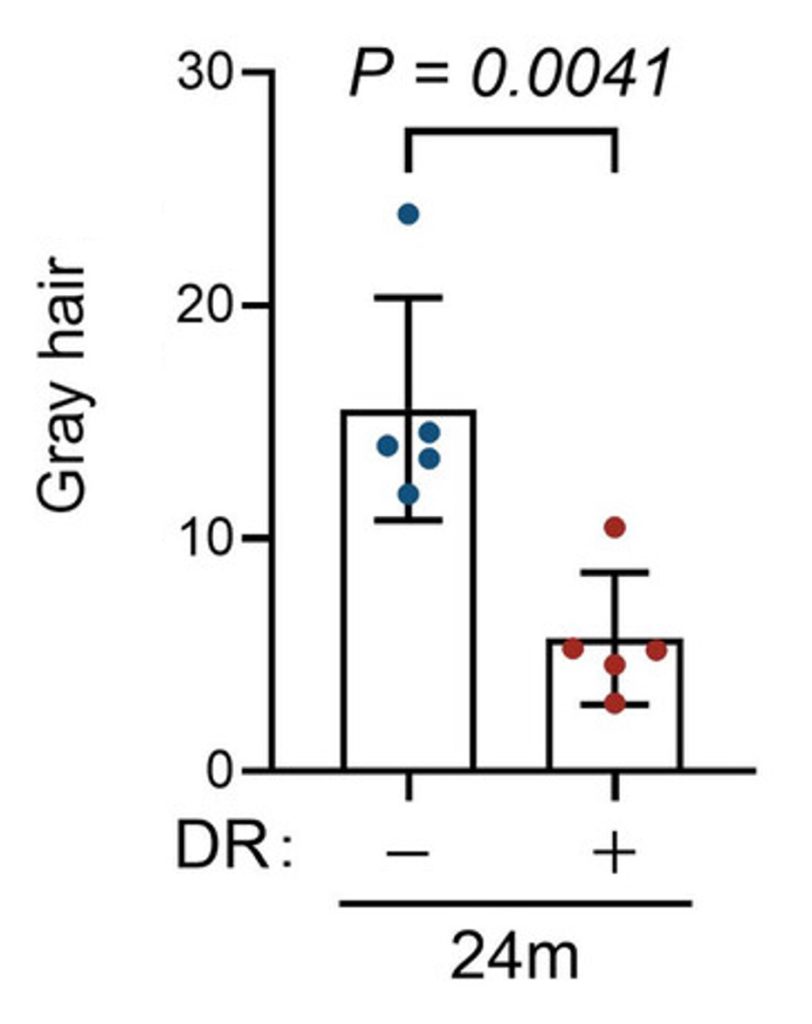New Study Shows Senolytic Supplements Prevent Hair Graying
The senolytics dasatinib and quercetin (DQ) prevent hair graying in mice that model human skin aging.
Highlights
- A hormone called insulin growth factor increases with age in the skin and is associated with accelerated aging.
- In mice that model skin aging via high insulin growth factor levels, hair graying is prevented by activating longevity-associated sirtuins, senolytics, or dietary restriction.
Cellular senescence plays a key role in the progression of aging and age-related conditions, including skin aging. Intriguingly, scientists are now uncovering that cellular senescence affects the cells responsible for hair pigmentation. For this reason, researchers from the Mayo Clinic and Sichuan University in China explored how senolytics — compounds that reduce cellular senescence — affect hair graying.
Remarkably, their findings reveal that senolytics can prevent age-associated hair graying. Not only this, but the researchers also determined that a key link between skin aging and hair graying is a protein called insulin-like growth factor-1 (IGF-1).
A Hormone that Promotes Aging
IGF-1 is a hormone that promotes cellular proliferation and growth. High IGF-1 levels are associated with age-related diseases like cancer and increased mortality risk. Thus, high IGF-1 levels may promote the acceleration of biological aging. With that said, the Mayo and Sichuan researchers found elevated IGF-1 levels in the skin of both naturally aged mice and older women, revealing that skin IGF-1 levels increase with aging.

To confirm that IGF-1 contributes to aging, the researchers generated mice that express high levels of IGF-1 in their skin. Incredibly, they found that, compared to normal mice, these IGF-1 mice lived substantially shorter lives, suggesting that high skin IGF-1 levels run counter to longevity (living longer). The IGF-1 mice also exhibited signs of premature aging, including frailty, poor coordination, hair graying, and hair loss.
To confirm that high levels of IGF-1 accelerate skin aging, the researchers compared the genes of the IGF-1 mice to those of naturally aged mice. They found that genes linked to hair follicle development, hair growth, and stem cell activation were similarly altered in both IGF-1 mice and naturally aged mice. These findings suggest that IGF-1 accelerates hair follicle aging by disrupting hair follicle function.
Preventing Hair Graying
One of the key features of aging tissues and organs is senescent cells, which accumulate throughout the body. Senescent cells even accumulate within hair follicles, as shown by the Mayo and Sichuan researchers in naturally aged mice. Senescent cells were also detected in the hair follicles of IGF-1 mice, suggesting they recapitulate natural senescence. Still, this was not surprising, as, in a previous study, the researchers showed that IGF-1 induces premature senescence.
Activating Sirtuins Prevents Hair Graying
In their previous study, the researchers showed that IGF-1 diminishes the activity of a longevity-associated enzyme called sirtuin-1, leading to the induction of cellular senescence. With this in mind, the researchers increased the activation of sirtuin-1 in IGF-1 mice by breeding them with mice that overly express sirtuin-1 in the skin. This not only led to a reduction in senescent skin cells but also prevented hair graying, suggesting that activating sirtuins can prevent hair graying.

Senolytics Prevent Hair Graying
To directly eliminate the hair follicle senescent cells in the IGF-1 mice, the researchers employed the senolytic combo DQ. In addition to reducing cellular senescence levels, DQ prevented hair graying, much like activating sirtuin-1 prevented hair graying. These findings raise the question of whether combining senolytics with sirtuin activation could additively reduce or prevent hair graying.

Dietary Restriction Prevents Hair Graying
Dietary restriction, in the form of reducing the proportion of calories consumed per day, is known as one of the most powerful health and longevity-promoting interventions. Moreover, dietary restriction is recognized for its ability to modulate IGF-1. As such, the researchers reduced the number of calories consumed by the IGF-1 mice by 30%, which prevented hair graying. Crucially, dietary restriction also reduced hair graying in naturally aged mice.

Will This Work in Humans?
The researchers showed that sirutin activation, senolytics, and dietary restriction can prevent hair graying in IGF-1 mice. However, in the case of naturally aged mice, they only showed that dietary restriction prevented hair graying. Future studies will be necessary to determine if sirutin activators or senolytics can prevent hair graying in naturally aged mice, rather than an IGF-1-based mouse model for skin aging.
Of course, naturally aged mice are still far from being naturally aged humans. While it was shown that dietary restriction prevented hair graying in naturally aged mice, there is no evidence that this occurs in humans. Nevertheless, this could be because it may be difficult for most individuals to sustain a caloric deficit of 30% for 6 months, like the mice. Still, the lack of human evidence for the dietary restriction experiment calls into question the other experiments.
With that being said, senolytics hold promise in not only preventing hair graying but also multiple facets of aging. For example, in the case of DQ, this senolytic combo was shown to be safe in patients with Alzheimer’s disease, which should lead to further clinical trials. DQ has also been tested against other age-related diseases like lung disease and diabetic kidney disease. As more clinical trials are conducted, we may find that senolytics combat hair graying and also more serious conditions associated with aging.
Model: Mice with high levels of IGF-1 in their skin
Dosage: 5 mg/kg of dasatinib and 50 mg/kg of quercetin administered orally

